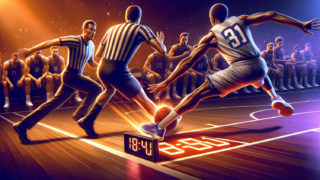
What’s an Air Ball in Basketball?
Written by: Basketball Universe
Last updated:

When it comes to basketball, even the most casual fans have heard of spectacular slam dunks and game-winning shots. But amidst the thrilling moments, an incident referred to as an ‘Air Ball’ might leave many scratching their heads. In this engaging and comprehensive blog post, we’ll delve into the intricate world of an Air Ball, exploring its definition, significance, and the social dynamics that surround this curious event. So lace up your sneakers and join us as we take a journey through flightless hoops and the rich culture that lies within!
What’s an Air Ball in Basketball?
An Air Ball is a basketball term used to describe a shot attempt that completely misses the rim, backboard, and net. It is often a result of poor shooting technique or an inaccurate estimation of distance, leading to a failed scoring opportunity. Air Balls can occur during both casual and professional games, and they are usually met with varying levels of disappointment and ridicule.
Mastering the Art of the Shot: The Key Factors
Before delving into the air ball phenomenon, it’s important to understand the key elements that contribute to a successful shot in basketball. By mastering these techniques, players can reduce the likelihood of air balls in their gameplay. The central components include accuracy, power, and consistency.
Accuracy: Aim and Angle
One’s ability to direct the ball towards the hoop with precision is the cornerstone of a successful shot. To hone this skill, players need to work on their aim and use the appropriate angle to maximize their chances of making the basket. Developing muscle memory through practice and repetition is the key to improving accuracy.
Power: Force and Follow-through
Applying the right force to project the ball into the air is crucial when attempting a shot. Players must learn to harness their body strength efficiently, employing their legs and arms in unison for a smooth follow-through. Shooting with too little or too much power can contribute to air balls, making it essential to strike the appropriate balance.
Consistency: Repetition and Technique
Refining one’s shooting mechanics and practicing consistently are the secrets to achieving a high level of skill in basketball. Players should strive to maintain the same form, balance, and release on every shot to build a reliable, repeatable technique. With consistent practice, the instance of air balls will naturally, and significantly, decrease.
A Deeper Dive into Air Ball Occurrences and their Reasons
Now that we’re equipped with the fundamental knowledge of an effective shot, let’s investigate the factors that may cause an air ball. It’s essential to identify these aspects so players can make appropriate adjustments and minimize air balls in their games. A few common reasons for air balls include fatigue, pressure, lack of focus, and improper form.
Fatigue: A Tired Player’s Foes
Endurance and stamina are critical in maintaining optimal performance throughout a basketball game. As fatigue sets in, a player’s body and mental alertness are affected, causing shooting technique and force application to deteriorate. This can often manifest into air balls, making it vital for players to manage their energy and condition their bodies for peak performance.
Pressure: The Psychological Impact
Emotions can significantly impact a basketball player’s performance on the court. High-pressure situations, such as last-minute shots or free-throw attempts, can lead to an increased heart rate and nervousness. These factors can affect a player’s accuracy, resulting in a misjudged shot attempt that ultimately becomes an air ball. Developing techniques to handle pressure and stay composed during critical moments can help mitigate air ball occurrences.
Lack of Focus: Distractions and Mindfulness
A basketball game can be a sensory overload for players, with constant noise, movement, and visual stimuli. It is crucial for players to remain focused and mindful during their shot attempts, filtering out distractions so as not to disrupt their shooting mechanics. Losing focus increases the risk of an air ball, making it essential for players to maintain their concentration on the task at hand.
Improper Form: The Root of the Problem
Lastly, a player’s shooting form is instrumental in reducing air ball occurrences. When players deviate from the proper form—whether consciously or unconsciously—misjudged shots become inevitable. Continuously analyzing and refining shooting mechanics while paying attention to factors such as ball grip, follow-through, and body position will assist in reducing air balls during gameplay.
Basketball Rules: How an Air Ball Affects the Game
Under basketball rules, an air ball is simply a missed shot that doesn’t make contact with the rim, backboard, or net. Although it can evoke laughter, ridicule, or disappointment, an air ball by itself does not yield a penalty. However, there are a few rules and gameplay implications associated with it:
Shot Clock Rules
In professional leagues, shot clocks help maintain the pacing and excitement of a basketball game. It requires teams to attempt a shot within a specific time frame. If a player shoots an air ball and the offensive team retrieves it, but the shot clock has not been reset due to a failure to hit the rim, the team may need to act quickly to avoid a shot clock violation.
Jump Ball and Possession
If a defensive player blocks a shot, causing it to miss the rim and result in an air ball, a jump ball situation may arise depending on how the ball is contested. In this case, the referees will consider the specific circumstances to decide whether a jump ball should be conducted, or possession should be awarded to one of the teams.
Stepping up the Defense
Air balls can lead to turnovers and fast break opportunities for the opposing team. Therefore, players should always be prepared to transition quickly from offense to defense in case of an air ball, making sure to minimize the advantage gained by their opponents due to the missed shot.
Air Balls and Basketball Culture: The Social Significance
While air balls may be a common occurrence on the court, they hold a unique and quirky significance within basketball culture. From enthusiastic fans to animated teammates, the air ball serves as a playful rallying point and a source of amusement within the basketball community.
The “Air Ball” Chant
When an air ball occurs during a game, fans often revel in poking fun at the player by chanting “air ball” each time they attempt a shot afterward. This chant is particularly popular during high-school and college games and is a means of adding an element of jest and sportsmanship to the event.
Teammates and Encouragement
In contrast to the playful taunts of fans, teammates are more likely to support a player who has shot an air ball. Consoling the player and offering encouragement can boost morale, helping them move past the air ball and perform with renewed confidence for the remainder of the game.
Reducing Air Ball Instances: Effective Drills and Tips
By now, you’re well-aware of the factors that contribute to air balls and their implications on basketball gameplay. It is crucial for players seeking improvement to develop their shooting technique and accuracy consistently. Below are a few select drills and tips designed to support that endeavor:
Form Shooting Drills
Form shooting drills focus on refining shooting mechanics from a stationary position or at a close range to the hoop. This allows players to master the fundamentals—such as aiming, releasing, and follow-through—without the distraction of movement or distance. Practicing regularly will translate to an improved shooting performance on the court.
B.E.E.F. Technique
The B.E.E.F. (Balance, Eyes, Elbow, Follow-through) technique is a simple mnemonic that assists players in remembering the basic components of proper shooting form. Incorporating this approach in practice will reinforce the elements of a successful shot, gradually minimizing air ball occurrences during games.
Arc Shooting Drills
A basketball must follow a trajectory with a suitable arc to maximize the chances of scoring. Players can utilize arc shooting drills—focusing on perfecting their shot’s angle and height—to develop an optimally arched shot capable of avoiding air balls.
Mental Preparation Techniques
Last—but not least!—mental preparation plays a key role in air ball prevention. Players should develop strategies for managing pressure, maintaining focus, and building self-confidence, ensuring that their mental state remains in peak condition during critical moments on the court.
Turning Air Balls into Opportunities
Air balls, while considered a blunder in basketball, can also serve as necessary learning experiences. By analyzing air ball occurrences and adopting lessons drawn from them, players can make important adjustments to their approach, turning these mishaps into opportunities for growth and skill development. Here are a few strategies for integrating the knowledge gleaned from air balls into your gameplay:
Identifying Patterns
Reflecting on air ball instances and identifying patterns can be incredibly beneficial. For example, if a player tends to shoot air balls more frequently during long-range attempts, this could indicate the need for further practice and improvement in their shooting technique from distance. By pinpointing these patterns, players can effectively focus their efforts on specific skill sets and achieve targeted growth.
Embracing the Challenge
Using air balls as motivation can foster a growth mindset that encourages players to push their boundaries and strive for progress. Treating each air ball as a reason to work harder, build stronger skills, and become more confident on the court will enable players to turn these errors into assets, fueling their development rather than impeding it.
Practicing under Pressure
Simulating high-pressure situations during practice can help players become accustomed to the nerves and emotions that accompany these moments. Acclimating to these scenarios will assist players in maintaining composure and preventing air balls when the stakes are high. Drills such as head-to-head shooting competitions or timed free throw attempts can create the necessary sense of urgency and pressure to prepare players effectively.
Knowing How to React to an Air Ball
It is also important for both players and coaches to know how to react and respond to an air ball during a game. An appropriate response can contribute to better team dynamics and maintaining morale during critical moments of play.
The Coach’s Role
Coaches play an essential part in shaping and guiding their players during games. When a player shoots an air ball, it is crucial for the coach not to exacerbate the situation but provide constructive feedback, encouragement, and support. This approach will help to ensure that the player’s confidence remains intact, preventing a single air ball from causing lasting adverse effects.
Teammate Support
As mentioned earlier, teammates’ support is invaluable in the aftermath of an air ball. Ensuring a healthy, supportive team culture can make all the difference in helping players recover quickly from an air ball, allowing them to refocus and continue playing at their best as the game progresses. By lifting up teammates in moments of disappointment, a team’s overall resilience and competitiveness is bolstered.
Player Mindset
Finally, it’s essential for the player who shot the air ball to adopt the right mindset. Rather than succumbing to embarrassment or frustration, maintaining a positive attitude and learning from the experience are key. Embracing this perspective will lead to greater mental toughness, as well as a higher likelihood of success during future shot attempts.
With this added knowledge, you are now fully equipped to understand, analyze, and respond to air balls in basketball effectively. Embrace the lessons they provide and appreciate the valuable role they play in the ongoing quest for skill development, mastery, and success on the court.
Frequently Asked Questions (FAQs)
In this section, we will address some frequently asked questions related to air balls in basketball. Our aim is to provide concise, useful answers that will assist in broadening your understanding and satisfying any lingering curiosities.
1. What happens if an air ball goes out of bounds?
If an air ball goes out of bounds, possession of the ball is awarded to the team that did not touch it last. This typically means that the defensive team will take possession following an air ball that has gone out of bounds.
2. Does an air ball count as a rebound?
Yes, an air ball can be considered a rebound if a player retrieves it before it touches the ground or goes out of bounds. The player who secures the ball may be credited with either an offensive or defensive rebound, depending on their team’s role at the time.
3. Does a blocked shot that becomes an air ball impact the shooter’s field goal percentage?
A blocked shot that results in an air ball will negatively affect the shooter’s field goal percentage, as it counts as a missed field goal attempt. A player’s field goal percentage is calculated by dividing the number of made field goals by the total number of field goal attempts.
4. Can an air ball count as an assist?
An air ball cannot count as an assist, as it requires a made field goal by the shooter following a pass from a teammate. Since an air ball is a missed shot, it does not satisfy the criteria for an assist.
5. How should a player respond when fans chant “air ball”?
Players should maintain their focus, confidence, and composure when fans chant “air ball”. Ignoring the taunts, concentrating on the game, and demonstrating sportsmanship will allow players to handle these situations with grace and professionalism.
6. Is shooting an air ball considered a turnover?
An air ball by itself is not considered a turnover. A turnover occurs when a player loses possession of the ball to the opposing team through a steal, mishandled pass, or offensive foul. However, an air ball can indirectly lead to a turnover if it goes out of bounds, prompting the other team to gain possession.
7. Can a player save an air ball out of bounds?
A player can attempt to save an air ball from going out of bounds by jumping, catching the ball, and then passing it to a teammate while still in mid-air. If successful, this would prevent the loss of possession and potentially create a scoring opportunity for their team.
8. How can coaches address frequent air balls during practice?
Coaches should analyze the root causes of frequent air balls and address these issues by focusing on aspects such as improving shooting technique, building endurance, and developing mental strategies for handling pressure. Utilizing drills and exercises targeting these areas will elevate a player’s performance and reduce air ball occurrences.
9. Is it better to shoot an air ball or hit the side of the backboard?
From a tactical standpoint, there is little difference between shooting an air ball or hitting the side of the backboard since both are considered missed shots. However, hitting the side of the backboard may offer slightly higher chances of an offensive rebound, whereas an air ball could lead to a quicker transition for the defensive team.
10. Do professional players experience air balls?
Yes, professional players can also experience air balls. While it may be less common at the highest levels of play, even the most skilled players can occasionally miscalculate a shot, resulting in an air ball. This exemplifies the need for ongoing practice and refinement, regardless of one’s skill level.
Featured Posts
- No pillar pages found.





